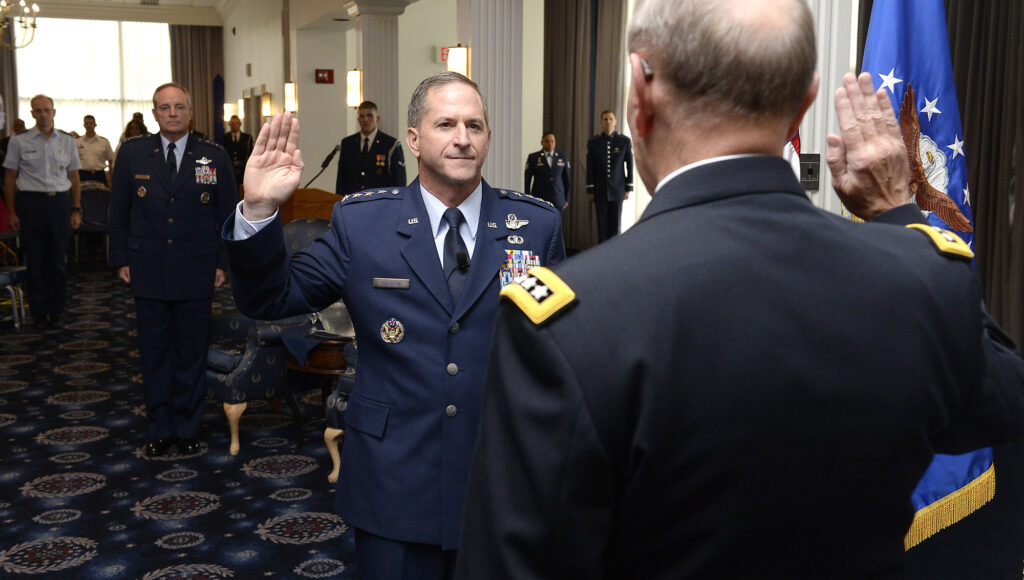
Gen. David Goldfein
UPDATED: Adds Air Force Statement
WASHINGTON: The administration’s nominee for Air Force Chief of Staff, Gen. David Goldfein, came before the Senate Armed Services Committee this morning promising to improve Air Force relations with Congress. And Goldfein delivered, to the point of apparently agreeing with a pleased SASC chairman John McCain that the service should release the value of the development contract for the B-21 Long-Range Strike Bomber.
The Air Force has opposed releasing this figure, and Goldfein’s own pre-hearing written testimony defended that position: “There is a strong correlation between the cost of an air vehicle and its total weight,” Goldfein (or rather his staff) wrote, “thus making it decisively easier for our adversaries to calculate the aircraft capabilities and develop countermeasures.”
 But after McCain enumerated all the reasons for disclosing the number to the public, saying the Air Force had already given our enemies plenty of information and denying this one piece just locked out the American taxpayer, Goldfein said, “Chairman, I agree with you. And I believe that if we’re not transparent with the American people on the cost of this weapons system, through its elected leadership, then we have a good chance of losing this program….”
But after McCain enumerated all the reasons for disclosing the number to the public, saying the Air Force had already given our enemies plenty of information and denying this one piece just locked out the American taxpayer, Goldfein said, “Chairman, I agree with you. And I believe that if we’re not transparent with the American people on the cost of this weapons system, through its elected leadership, then we have a good chance of losing this program….”
[UPDATE] It’s worth noting that McCain then cut Goldfein off — “I thank you very much for that” — and moved on to his next question, so the general may have had more to say. We asked the Air Force for clarification and got the following statement:
“Gen. Goldfein believes strongly that we must be as transparent as possible while balancing security concerns. Those areas that, if disclosed, would introduce security vulnerabilities, will be briefed in classified sessions to the elected leadership in Congress.”
Goldfein’s prepared answers would suggest that the development contract value would be a matter for such classified briefings — but that doesn’t square with saying “I agree” to McCain’s argument for public disclosure. [UPDATE ENDS]
Now, saying “I agree” with something is not the same as a promise to do anything about it. Goldfein is clearly acknowledging there’s a political problem, not so clearly saying what he’d do about releasing the particular figure.
But from a political standpoint, what matters is McCain said “thank you very much” and moved on happily to his next question. As Marine Corps Commandant Gen. Robert Neller could tell you, inadvertently triggering McCain’s attack mode during your confirmation hearing is (a) all too easy to do and (b) not fun.
Goldfein had fair warning to tread carefully because the Senate’s pre-hearing written questions asked bluntly about “the committee(‘s) frustration with the timeliness of responses from the Air Force” and the need “to improve the overall relationship between the Congress and the Air Force.”
“During my tenure as the Vice Chief (of Staff of the Air Force) and during my recent office visits with the members of this committee,” Goldfein wrote back, “I have heard concerns with our responsiveness to your requests for information, frustration with a lack of prompt access to senior Air Force leaders, and perceptions of a tendency to bring solutions to problems without a willingness to seek counsel and input.”
The general promised to be responsive to formal requests and — more important — “proactive” in reaching out informally. “The news I deliver will not always be good,” he wrote, “but I will make every effort to ensure that you are not caught off guard or otherwise found in a position of surprise.”
Setting aside any specific matter of policy, that kind of promise is music to a legislator’s ears.

EC-130 Compass Call electronic warfare aircraft, used for an experimental cyber attack
Gen. Goldfein addressed a host of issues in his confirmation hearing, and even through the usual caution of a nominee, you could hear some interesting hints as to his priorities.
Most immediately, there’s movement on nuclear modernization. In the next two weeks, Goldfein said, the Long-Range Stand-Off (LRSO) weapon — replacing the venerable Air-Launched Cruise Missile (ALCM) — will have its Milestone A review to launch a development program. The same fortnight will also see the publication of a formal Request For Proposals (RFP) on the Ground Based Strategic Deterrent (GDSB), the replacement for the geriatric Minuteman III intercontinental ballistic missile.
These two missiles — LRSO launched from bombers, GDSB from silos — are crucial to two of the three legs of the nuclear triad. Goldfein pledged to work closely with the Navy’s program to replace the sub-launched Trident missile: While launching from underwater is very different from launching from underground, many components could potentially be procured jointly.
As to how the Air Force would afford the two new missiles, the B-21, the F-35A Joint Strike Fighter, a replacement for the aging T-38 trainer, etc. etc. all in at the same time in the 2020s, Goldfein was short on specifics.
Because wholesale replacement of old systems is so expensive, much US military modernization consists of upgrades. Most often you put new electronics on old platforms, but in the case of the EC-130H Compass Call, the Air Force is doing the opposite: It wants to pull electronics off the old airframe and put them in something that can fly higher, allowing its high-powered jammers to reach more targets. Doing this requires Congressional approval for certain rapid acquisition authorities, which Goldfein urged a receptive McCain to approve.
Goldfein also voiced some interesting thoughts about another “non-kinetic” weapon system, lasers. While most attention (including ours at Breaking Defense) has focused on shooting down incoming missiles and drones, Goldfein saw a more offensive use for the soundless, invisible beams. (Contrary to Star Wars, lasers aren’t visible to the naked eye unless they’re aimed directly at you — in which case you soon won’t be able to see them, or anything).
“I describe it as silent sabotage,” Goldfein said. “Right now…when we want to place firepower on the enemy, they and everyone else in the area know we’re there. What we need is the capability to create an effect and not have them know where it came from or who.” This would be especially useful for special forces, he said — Air Force Special Operation Command wants to put high-powered lasers on its AC-130 gunships — but would have applications across the Air Force.
Overall, however, when Goldfein looked at the Air Force’s future role, he emphasized not weapons, nor sensors, but command and control, “which is how we tie this all together,” he said. Command and control is a core Air Force mission — he didn’t give examples, but the service runs satellites, AWACS flying command posts, and perhaps future high-altitude drone relays — and it’s crucial for the roboticized future warfare envisioned by the Pentagon’s Third Offset Strategy.
After shooting down Iranian munitions, Jordan defiant in uncomfortable spotlight
Amid Iranian criticism, “Jordanian leaders have been very clear to portray their action as defensive and in protection of their own sovereignty rather than any act in support of Israel, and this is sincere,” an analyst told Breaking Defense.


























